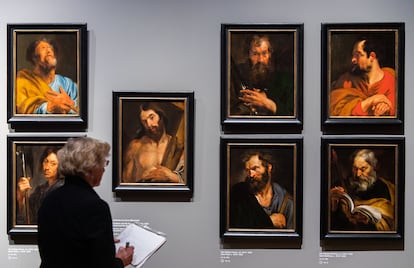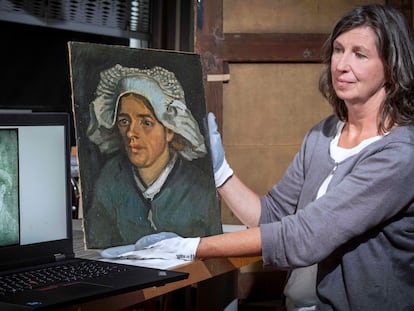From the living room to the vault: the story of a painting that no one knew was a Van Dyck
The Museum of Fine Arts of Seville has shown interest in a canvas by the Flemish painter that a family had in their home for several generations, unaware of its value or who painted it


The painting The presentation of the baby Jesus to Saint Barbara, by the Flemish painter Anton van Dyck, remains secure in an insurance company’s safe deposit box in Seville waiting to find out what its next destination will be. For several generations this canvas, measuring 130 by 92 cm, has been hanging in pride of place at a family home in Jaén (southern Spain). The family always looked at it with admiration, but little did they know that every day they were sitting under a masterpiece.
To the astonishment and disbelief of the family, a Madrid art company authenticated the painting as a work by Anton van Dyck (1599-1641) last year. Along with Rubens, the artist is considered the most important of the Flemish painters. The heir to this family legacy, who has been inundated with offers from famous auction houses, has the Museum of Fine Arts of Seville at the top of his list of buyers. Managed by the Junta de Andalucía, the museum has already shown its interest in adding the painting to their art collection.
The Andalusian Ministry of Culture confirmed to EL PAÍS that the family wrote to them in July to inform them of the existence of the canvas, but now they are waiting to resume contact to delve deeper into the matter. “If, as it seems, it is a Van Dyck, anything that enriches the collection of the Museum of Fine Arts is of interest to us, of course it is,” says a spokesperson from the Ministry. The painting is kept under lock and key and the owner, at the moment, has not allowed photos to be taken.
“The owner of the painting has no intention of speculating, but he does have a special interest in it staying in Seville, the city where the family now lives and with which he has a special connection,” says Luis Baena, the lawyer representing the painting’s owner, who wishes to remain anonymous for the moment. Van Dyck is a key painter in the development of the Sevillian baroque due to the influence he had among 17th century artists.
It is thought that the painting might have reached the home of this family in Jaén through Seville (where part of the family lived) in the 17th century. This was when more than a hundred Flemish families, mainly merchants and bankers, settled in the Andalusian city. After its authenticity was certified, the canvas, which showed obvious signs of deterioration as it was a painting from the first third of the 17th century, was restored by a workshop of renowned Andalusian professionals.
At the moment, The presentation of the baby Jesus to Saint Barbara does not have an official appraisal, although its owners anticipate that they will ask for “a fair and reasonable price.” In any case, it is known that, after coming to light, this work of art will be significantly revalued. Just this year, art collector Albert B. Roberts bought an oil sketch of Saint Jerome with an angel that had been found in a shed in upstate New York for over $600. After offering the work to Sotheby’s auction house, he sold it for more than $3 million. Part of those profits went to the Albert B. Roberts Foundation, which provides financial support to artists and various charities.
“It is very difficult to specify an approximate value of this type of work of art. Each painting has its own features,” says Consuelo Durán, who manages the Durán auction house. In any case, up to more than €9 million ($9.4 million) have been paid for Anton van Dyck’s works in the past. That was the amount that Alfred Bader and Philip Mold paid in 2009 at an auction at Sotheby’s in London, which set a record for works by the Flemish painter.
In a case similar to what occurred with the Andalusian family, a priest from the county of Cheshire in the United Kingdom bought a portrait for £400 ($482) in 2014. It was later revealed that it was a sketch of one of the magistrates that the Dutch artist portrayed in 1634. The resulting painting decorated the walls in Brussels city hall until it was destroyed in a French attack on the Belgian capital 61 years later.
Anton Van Dyck became the first court painter in England after a long stay in Italy. He is universally known for his portraits of the Genoese nobility and of Charles I, king of England and Scotland, his family members and his court. In addition to portraits, for which he was highly appreciated, he also dealt with biblical and mythological themes, introducing some notable pictorial innovations.
Sign up for our weekly newsletter to get more English-language news coverage from EL PAÍS USA Edition
Tu suscripción se está usando en otro dispositivo
¿Quieres añadir otro usuario a tu suscripción?
Si continúas leyendo en este dispositivo, no se podrá leer en el otro.
FlechaTu suscripción se está usando en otro dispositivo y solo puedes acceder a EL PAÍS desde un dispositivo a la vez.
Si quieres compartir tu cuenta, cambia tu suscripción a la modalidad Premium, así podrás añadir otro usuario. Cada uno accederá con su propia cuenta de email, lo que os permitirá personalizar vuestra experiencia en EL PAÍS.
¿Tienes una suscripción de empresa? Accede aquí para contratar más cuentas.
En el caso de no saber quién está usando tu cuenta, te recomendamos cambiar tu contraseña aquí.
Si decides continuar compartiendo tu cuenta, este mensaje se mostrará en tu dispositivo y en el de la otra persona que está usando tu cuenta de forma indefinida, afectando a tu experiencia de lectura. Puedes consultar aquí los términos y condiciones de la suscripción digital.
More information
Archived In
Últimas noticias
Welcome to the post-religion era: The idea of Christianity as the absolute truth has become obsolete
‘I thought you would like it’: The risky sexual practice popularized by TV shows and TikTok
The digitalization of tourism: ‘They promise experiences and gave us the worst possible one’
Mexican peso defies uncertainty with forecasts of a new period of stability in 2026
Most viewed
- Sinaloa Cartel war is taking its toll on Los Chapitos
- Reinhard Genzel, Nobel laureate in physics: ‘One-minute videos will never give you the truth’
- Oona Chaplin: ‘I told James Cameron that I was living in a treehouse and starting a permaculture project with a friend’
- Why the price of coffee has skyrocketed: from Brazilian plantations to specialty coffee houses
- Silver prices are going crazy: This is what’s fueling the rally










































